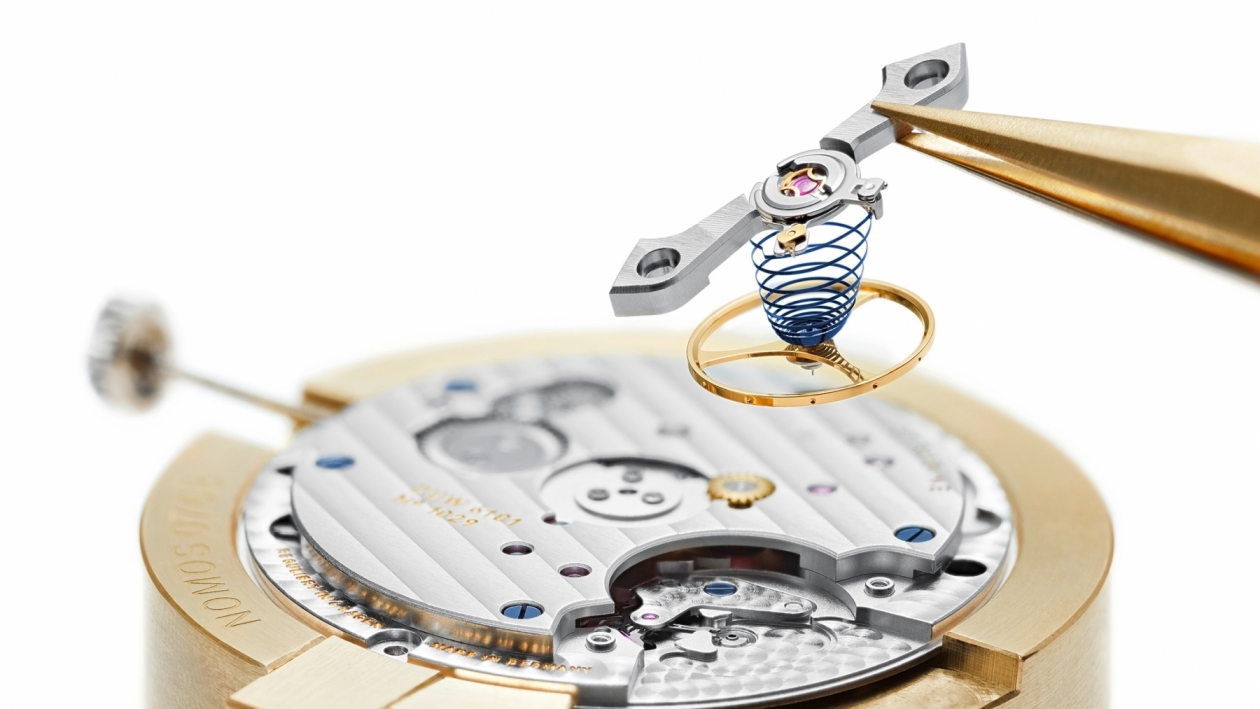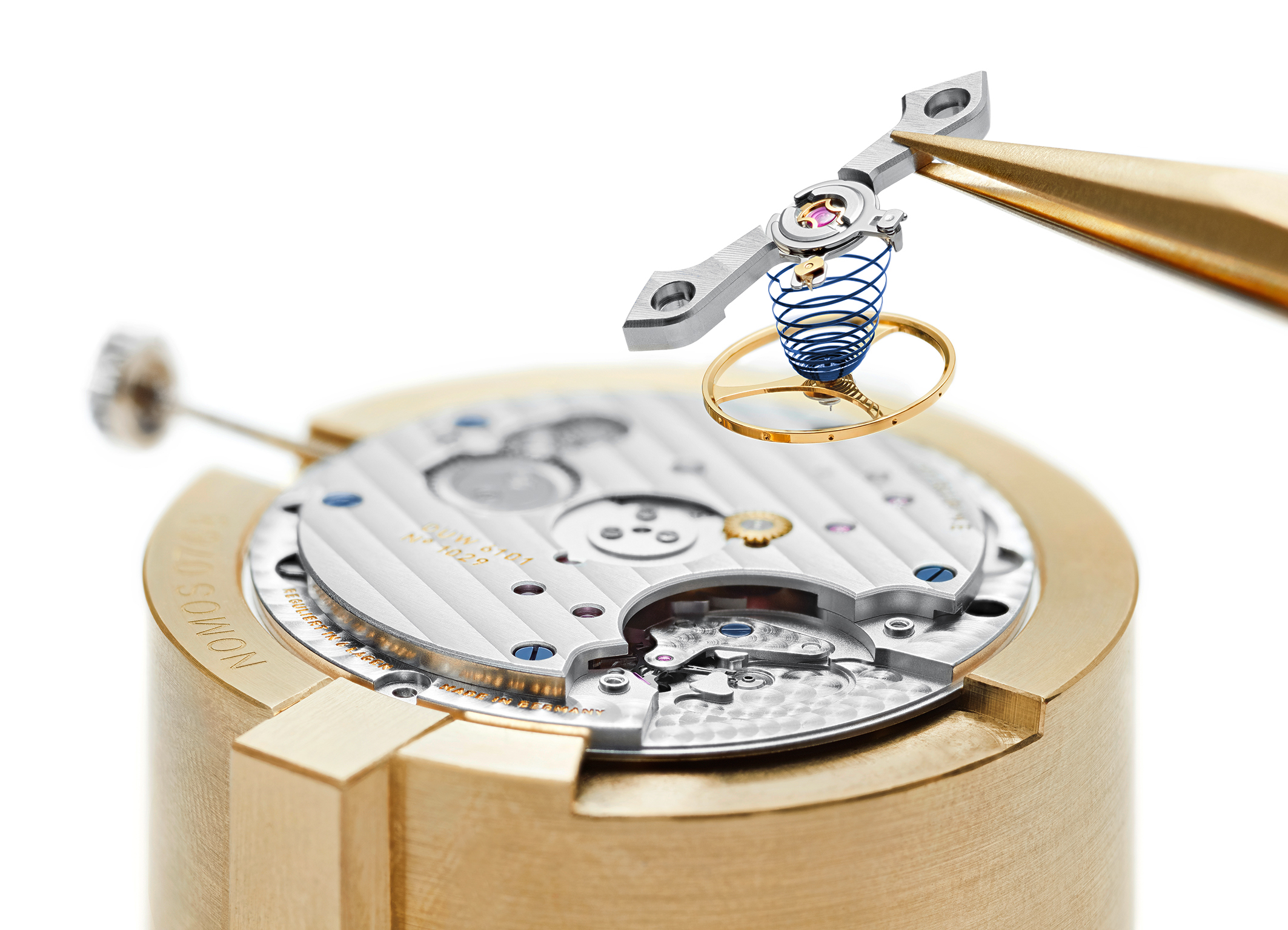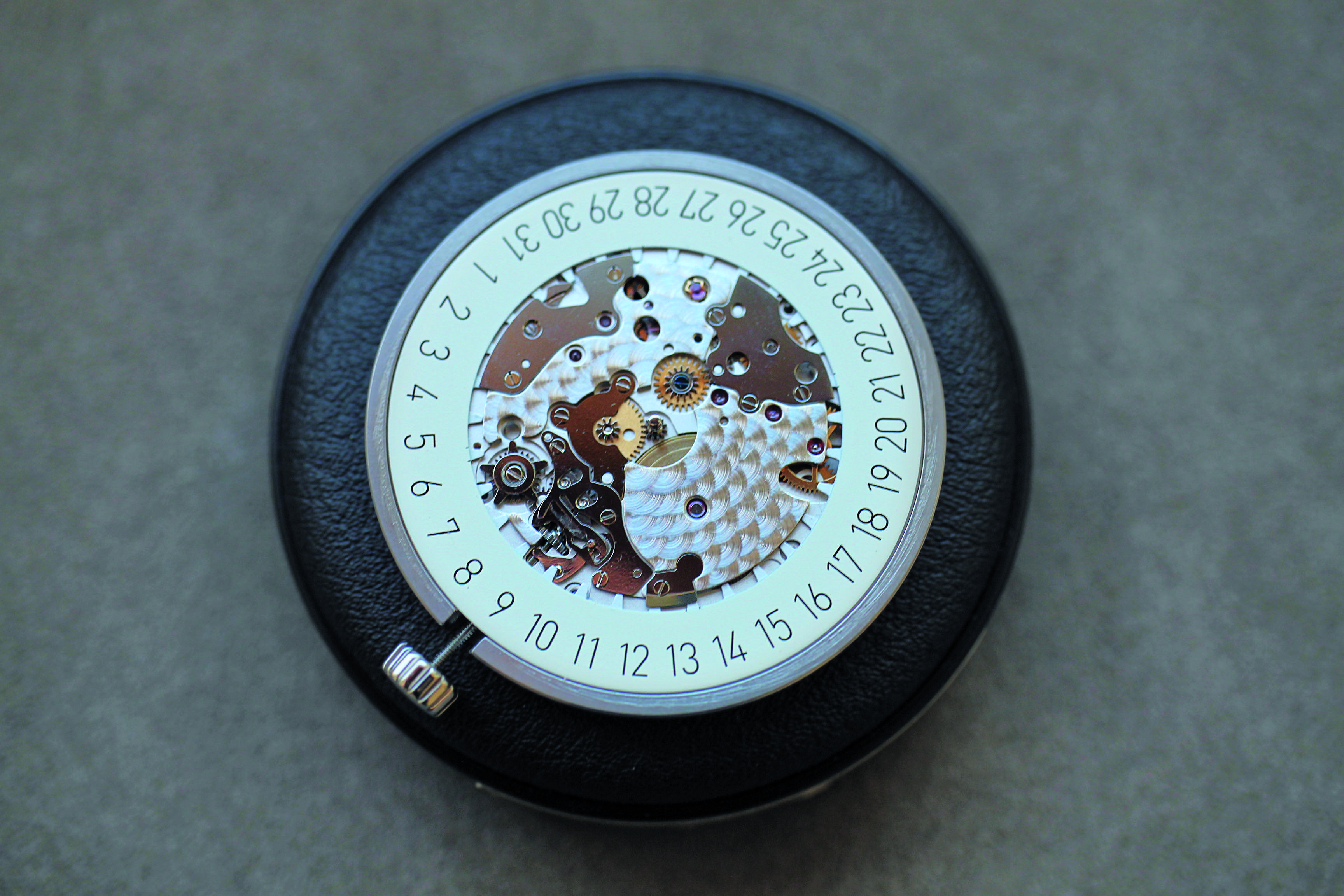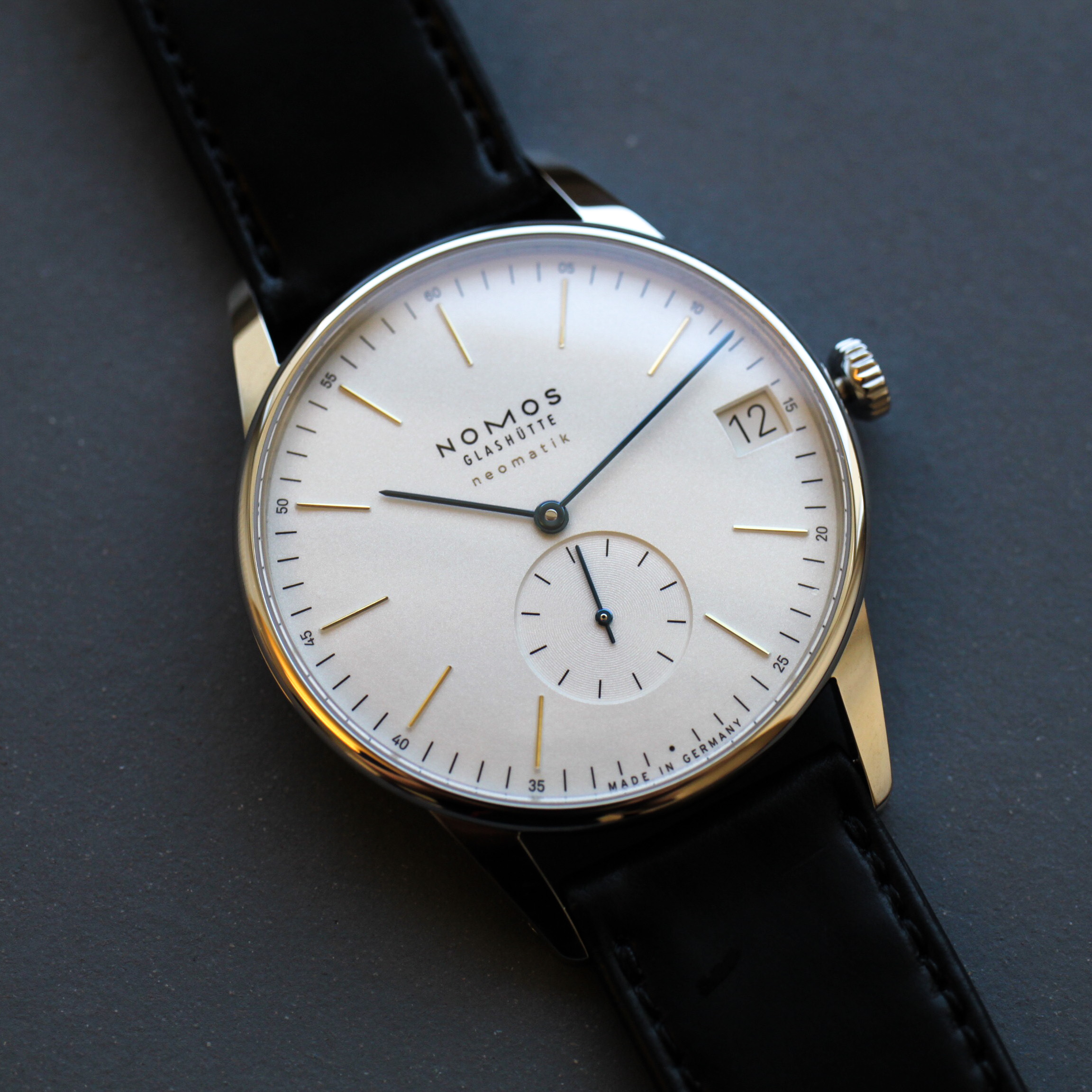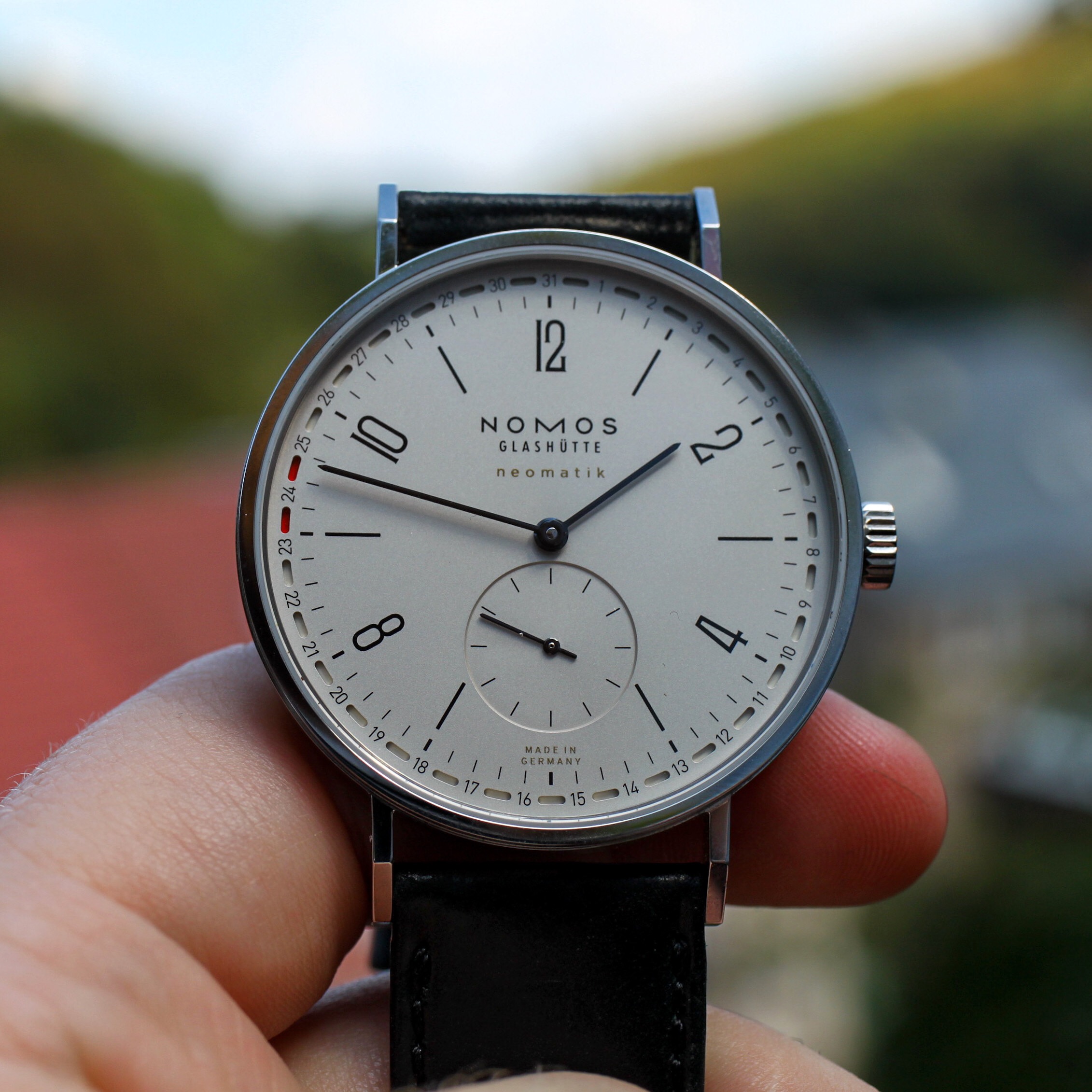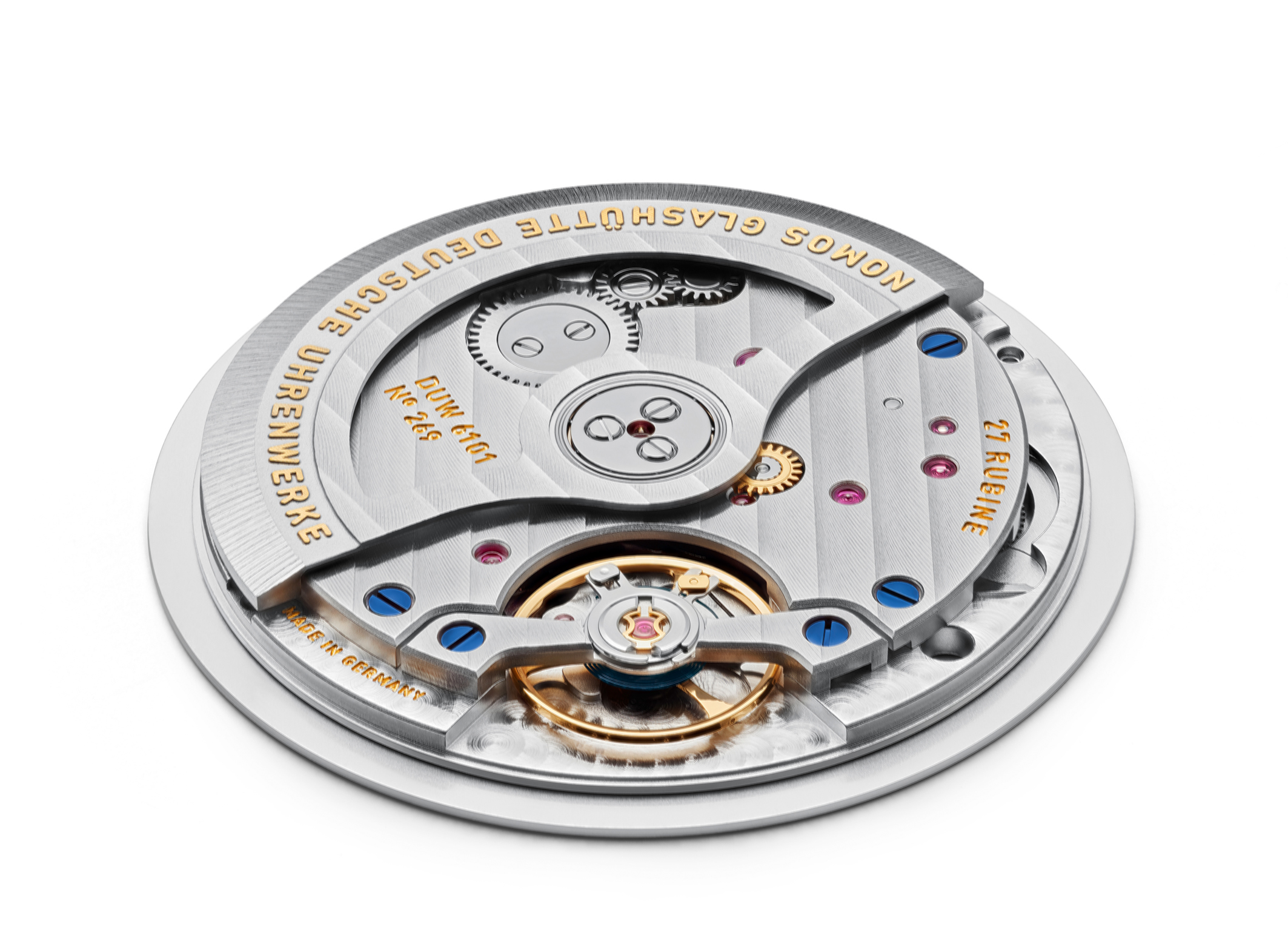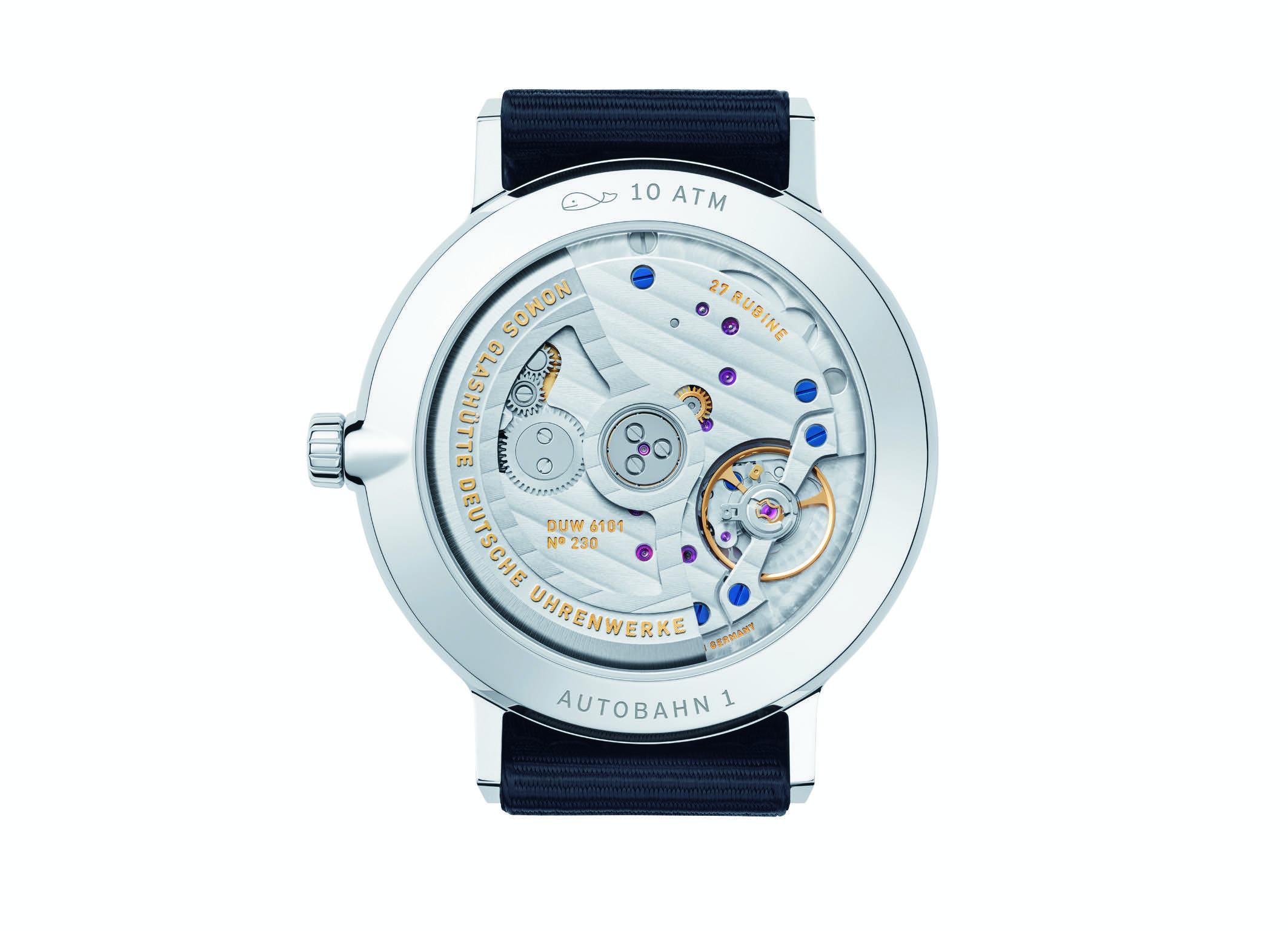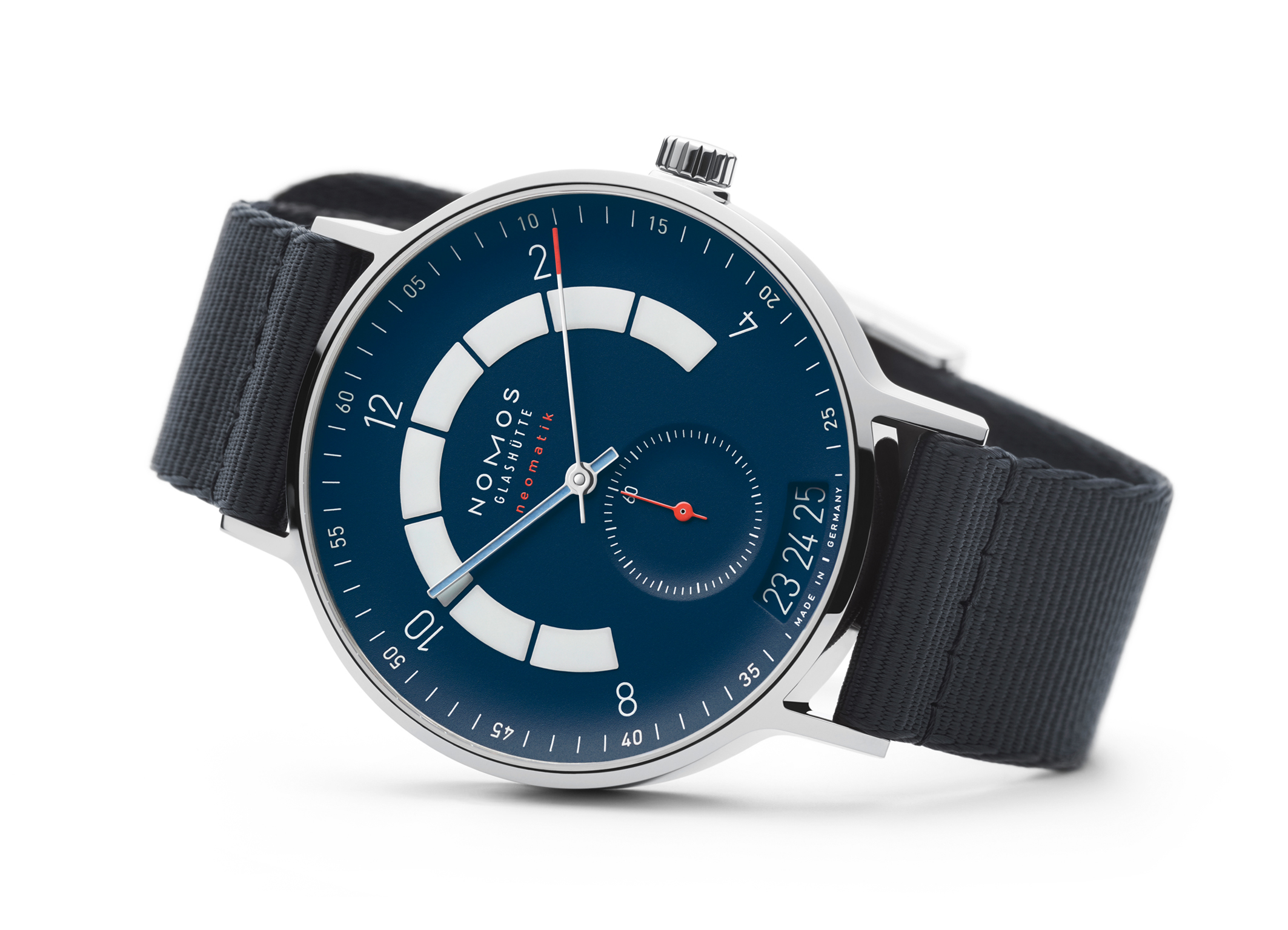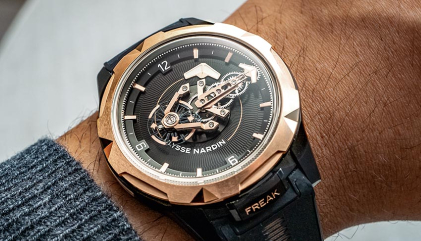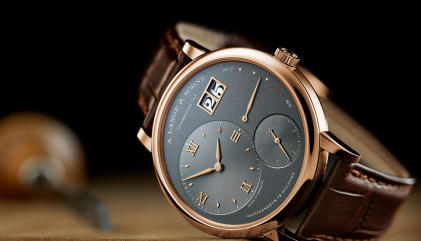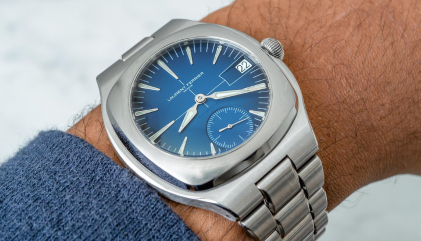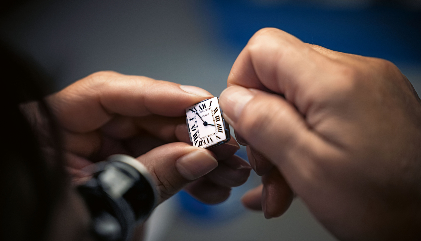In 2018, Nomos introduced a number of intriguing novelties; however, the real story was not the timepieces themselves, but the new movement inside. Cased within the new Autobahn and Update collections was the DUW 6101 calibre, the first neomatik movement featuring a date complication. Before getting into the steps that Nomos took to release what is arguably its most important in-house movement yet, a look into its development as a full-fledged manufacture is needed.
Founded by Roland Schwertner just months after the fall of the Berlin Wall in 1990, Nomos took a gradual approach to building out
its capabilities during those early years. In 1992, after two years of R&D by Schwertner’s trio of watchmakers, the first four Nomos watches were released. These models – headlined by the Tangente – have been the pillars of Nomos ever since and can still be found in its contemporary collection of timepieces that have grown to include 13 different lines of wristwatches. There was a major difference between the watches released in those initial 15 years and what has been revealed since. Nomos sourced Swiss movements from ETA and Peseux that were then hand-adjusted and put through final assembly at the brand’s headquarters in Glashütte. It wasn’t until 2005 that Nomos released its first in-house movements with the manual-winding Alpha calibre and the self-winding Epsilon.
Since that seminal year, Nomos has limited itself to the sole production of timepieces using in-house movements and, in turn, has grown exponentially. The small team of Schwertner and his three watchmakers has increased to over 300 employees around the world. The apartment where Schwertner had to share a telephone with the bistro next door has evolved into three buildings and a small boutique spread throughout the small town. More importantly, Nomos has become the largest producer of mechanical timepieces in all of Germany, dwarfing the output of its Glashütte neighbors and the dozens of other brands spread throughout the country.
Despite those first steps toward absolute independence in the mid-2000s, there was still the elusive question of how to construct an escapement. The escapement is, of course, what makes any mechanical timepiece tick. Its production is somewhat of a lost art in contemporary horology and those that have the know-how keep it close to their vest. In fact, a huge majority of brands – even on the extremely high end – purchase their escapements from the Swatch Group’s Nivarox division. To combat this near monopoly, Nomos partnered with the Technical University of Dresden and poured over 12 million euros into finding a solution. After seven years of research, the Nomos Swing System was finally unveiled in 2014 inside the Nomos Metro Datum Gangreserve and became instantly recognisable thanks to its tempered blue balance spring and its balance bridge fixed with screws on both sides. The Swing System was soon followed by the release of the DUW (Deutsche Uhrenwerke) 3001 neomatik calibre in 2015, becoming the brand’s first movement that could boast full manufacture status from concept to completion.
The DUW 3001 was the inaugural neomatik calibre, meant to signify a new era at Nomos filled with entirely in-house-produced automatic movements that quickly spread to a majority of the brand’s collections. It was remarkable not only for being the tangible realisation of vertical integration, but also for its resolute thinness. At only 3.2 mm in height, the DUW 3001 became one of the slimmest, full-rotor, automatic movements on the market. It accomplished this by placing almost the entirety of the movement parts between the bottom plate and the visible three-quarter plate, a compact space that on average had a clearance of a single millimetre. Nomos also constructed a thinner mainspring resulting in a weaker tensile force value that had to be made up by increasing the movement’s overall efficiency to 94.2 percent. One of the reasons for this is the introduction of the Nomos “rotor brake,” which stops the rotor from excessive winding, reducing overall wear and tear. Nomos teased the movement’s thinness in a memorable series of ads comparing the calibre with a stack of nine postage stamps.
The release of the Swing System and DUW 3001 calibre was a statement of autonomy for the German brand that, at the time, was only a quarter-century old. It immediately placed Nomos in an enviable position among marques of all sizes and price ranges. Rather than rest on its laurels, Nomos promptly started work on its second neomatik movement, setting its sights on the development of a quick-change date.
This brings us to Baselworld 2018 with the release of the Werner Aisslinger-designed Autobahn collection and the new Update range comprised of “updates” to the Tangente, Ludwig and Orion models. The DUW 6101 neomatik calibre is found inside all of these watches, numbering six in total.
The most discussed aspect of these models during the Baselworld showcase dealt with the size. One of the more recognisable Nomos ideals throughout its first 27 years was a resistance to the overarching trend of men’s watches that breached 40 mm. Each Nomos watch stayed consistently in the sub-40-mm arena without straying. That has changed with these six watches, each coming in at 41 mm due to the overhauled neomatik calibre.
Using the DUW 3001 as its base, the DUW 6101 was completely redesigned to integrate a large date ring on the outside of the movement and to adjust the seconds indicator from the central hands to a subdial at 6 o’clock. The winding system was reworked from start to finish as well. Despite the 6101’s substantial width of 35.2 mm with its date wheel (compared to the 3001’s 28.8 mm diameter), the movement is still quite thin at only 3.6 mm, thanks in part to the double-click gear, the duplex wheel and the rotor-immediate wheel taking over the function of the 3001’s “rotor brake.” Other necessary details include its 188-part, 27-jewel construction and 42-hour power reserve.
What’s unique about the 6101 for Nomos is that, for the first time, the movement features three different crown positions. At its home position, the watch can be wound by hand if so desired; placing the crown in its second position allows for the date to be set; finally, when the crown is fully pulled out, the time can be adjusted. The 6101’s most remarkable attribute, however, is a quick-change and bidirectional date mechanism that allows you to safely set the date both forward and backward.
The oft-criticised and under-appreciated date is a complication that is much more elaborate than most enthusiasts and collectors give it credit for. The common quick-set date that you’ll see in watches at most price levels is limited by a number of factors. Namely, the fact that you can typically only set it forward in time and that you aren’t supposed to change the date on a mechanical watch between approximately 10:00 p.m. and 2:00 a.m. (depending on the watch), because the date-change gear will likely be engaged with the date wheel’s teeth, preparing it to “jump” once midnight comes around. If adjusted while in progress, those teeth could be stripped clean, causing a total failure of the date mechanism and requiring immediate repair.
Most timepieces use a classic date-switch wheel that turns once every 24 hours and takes up a substantial part of the movement. The new method that Nomos developed involves dual, double-level wheels that are placed on opposite sides of the movement and are much smaller than the more common version. On one side of the DUW 6101 calibre is a double-level wheel with a hammer and cam placed on top that resembles a triangle with rounded sides that rotates four times a day. Nomos calls this a “program disc.” On its final turn of the day, the program disc activates a hook that pulls out and changes the date allowing for a shorter transition time. Opposite that is a second double-level wheel that connects to the teeth of the outer date wheel on its lower level, allowing the crown to set the date. The upper level has a star wheel enabling the date wheel to rotate quickly with the turning of the crown. The tension of these two levels acts as a security measure, similar to a movement-rotation clutch you might find in a car. These separate double-levels work together to keep the inexperienced enthusiast from harming his timepiece during that 90-minute period – 45 minutes before and 45 minutes after – surrounding midnight.
Basically how this works is the hammer from the first double-level wheel obstructs the date wheel’s teeth during the cautionary time period, just in case the crown is pulled into its second position to set the date. If the crown attempts to activate the date change in this time frame, the star wheel on the opposite double-level wheel will attempt to move the date wheel forward or backward but is blocked by the first double level wheel. Any pressure from these two wheels is alleviated courtesy of the lower level of the second double level wheel that independently rotates with the crown. The only way Nomos could make this possible is due to the exacting tension between the upper star wheel and its lower level stabiliser.
Nomos went through 11 different trials in the four years it took to develop the concept and apply it to the 6101 calibre. It’s a labyrinthine solution to a problem that most experienced watch lovers would never make the mistake of doing, but that’s the kind of consumer-friendly approach and build-out that has helped endear Nomos to its rapidly increasing fanbase. Knowledgeable watch enthusiasts and collectors can appreciate the steps Nomos is taking to fix a long-term issue with setting the quick-change date on a mechanical watch just as horological neophytes can appreciate its safety measure in the case of an expensive lapse in judgment.
The most visible application of the DUW 6101 in the six watches released this year is seen in a number of ways thanks to the date wheel’s placement around the movement itself. Throughout the Autobahn collection ($4,800), the date is shown at 6 o’clock through a large aperture that displays three dates at once and is meant to resemble an odometer in a hat-tip to the collection’s automobile aesthetic. The date’s placement in each of the three Update models is varied. The Update Tangente ($4,100) features the most innovative placement in a series of 31 apertures surrounding the dial. As the date transitions, red dots will flood the two apertures that frame the correct date. In the Update Orion ($4,200), Nomos’ classical dress watch receives its date placement at the conventional 3 o’clock spot as a nod to the model’s traditional styling. Finally, the Ludwig ($4,000), the only Nomos watch to feature Roman numerals (other than the California dial seen on the Club Campus), places the date squarely at 4 o’clock in its Update iteration.
Any discussion of a Nomos movement would be incomplete without mention of its finishing. Without fail, the DUW 6101 features quintessential German decoration that includes Glashütte ribbing, tempered blue screws and rhodium plating as well as Nomos’s signature perlage and sunburst polish. The engraving on the skeletonised rotor is embossed and gold plated. For the first time in a Nomos movement, the base plate of the DUW 6101 is engraved as well, reading REGULIERT IN 6 LAGEN, German for “adjusted in six positions,” a reminder of the movement’s fine adjustment.
The Nomos DUW 6101 neomatik calibre has refreshed the date complication and, in the process, made it a new cornerstone of the brand’s minimalist identity. Nomos has restrained itself from diving too deeply into the world of complications over its lifetime, instead opting to perfect its manufacture and experiment with case structure and Bauhaus-tinged dial design. By focusing on the improvement of its date display, Nomos is able to remain inside its wheelhouse while continuing to break down long-held horological beliefs and turn them into impactful – and accessible – timepieces.





